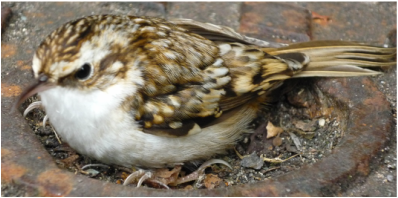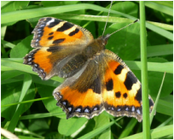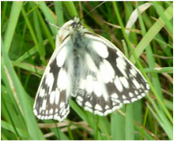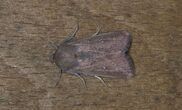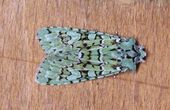Animals

As it was sunny on Thursday 15 December 2022, one of our Trustees decided to do her second annual survey, checking for brown hairstreak butterfly eggs on our site. They are absolutely tiny so need good light to spot them!
None were found last year, but she was thrilled to find 5 eggs! The photo on the right shows two eggs on a Blackthorn stem - this was sent into Butterfly Conservation who have confirmed that they are brown hairstreak eggs. A record of this on this has been submitted to the i-record website.
These eggs were found in the blackthorn area 3 of the Trust's management plan, which has the most suitable blackthorn suckers at the moment. We are hopeful that this new management plan might
result in increased numbers over the years.
The Heart of England Forest advises when conducting surveys of brown hairstreak eggs "If you find an egg approximately every 10 metres of hedge or 8 to 10 per hour you have found yourself a good colony". So this is really exciting!
None were found last year, but she was thrilled to find 5 eggs! The photo on the right shows two eggs on a Blackthorn stem - this was sent into Butterfly Conservation who have confirmed that they are brown hairstreak eggs. A record of this on this has been submitted to the i-record website.
These eggs were found in the blackthorn area 3 of the Trust's management plan, which has the most suitable blackthorn suckers at the moment. We are hopeful that this new management plan might
result in increased numbers over the years.
The Heart of England Forest advises when conducting surveys of brown hairstreak eggs "If you find an egg approximately every 10 metres of hedge or 8 to 10 per hour you have found yourself a good colony". So this is really exciting!
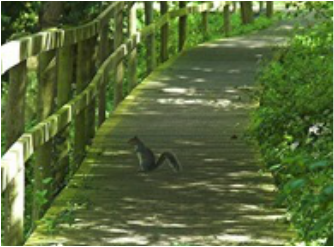 Grey squirrel on board walk
Grey squirrel on board walk
There are many different types of animals living on or visiting the
Millennium Green. There is evidence that foxes and badgers are
frequent visitors and roe and muntjac deer have also been seen. Grey
squirrels are frequently seen running along the rails round the moat.
Rabbits can often be seen particularly in the second field, scurrying
back to their holes in the protection of their holes in the early morning.
Smaller mammals include field voles which live in the longer grass, and
and moles which produce their characteristic molehills - not to be confused
with the numerous and growing number of ant hills.
|
As well as the usual garden birds, we get a variety of less well-known birds visiting the site such as whitethroats, chiff-chaffs, willow warblers, tree creepers and black caps. Nuthatches are seen and heard all year round and green woodpeckers have nested in holes in a tree on the island. Mallard ducks and moorhens nest on the most island every year. Overhead we regularly see ravens, buzzards and herons as well as pigeons and rooks. More unusual sightings have been red kites, a peregrine falcon and four cranes! |
 Common newt and dragonfly nymph
Common newt and dragonfly nymph
Grass snakes have at times found a home in the decaying
piles of cut grass and have been seen swimming in the moat.
Frogs, common newts and toads are found around and in the
ponds; frog spawn is sometimes seen in spring and the school
children catch tadpoles and baby newts when pond dipping.
One group were lucky enough to find a great crested newt.
|
A large variety of invertebrates are found in the varied habitats from the ponds, through trees, bushes and dead wood to the wildflower grassland. Each habitat supports its own collection of insects and other invertebrates. Highlights include dragonflies which breed in the ponds, shield bugs often found on bushes, burnet moths and red and black froghoppers in the grassland.
Butterflies and Moths: A regular butterfly survey is conducted every summer, with some twenty or so different species of butterflies identified. Among these are Marbled Whites which were until recently uncommon in this part of the country and are still quite localised. Other butterflies particularly associated with the wildflower grassland include Meadow Browns, Gatekeepers, Ringlets and Common Blues. In 2022, two moth experts from the Redditch area conducted a number of well-equipped surveys to identify moths living on the Green. Their results have been outstanding, with a sighting of a rare White Point Moth and the beautiful Merveille du Jour moth. The Trustees are very grateful to them for identifying these glories of the Green. |
